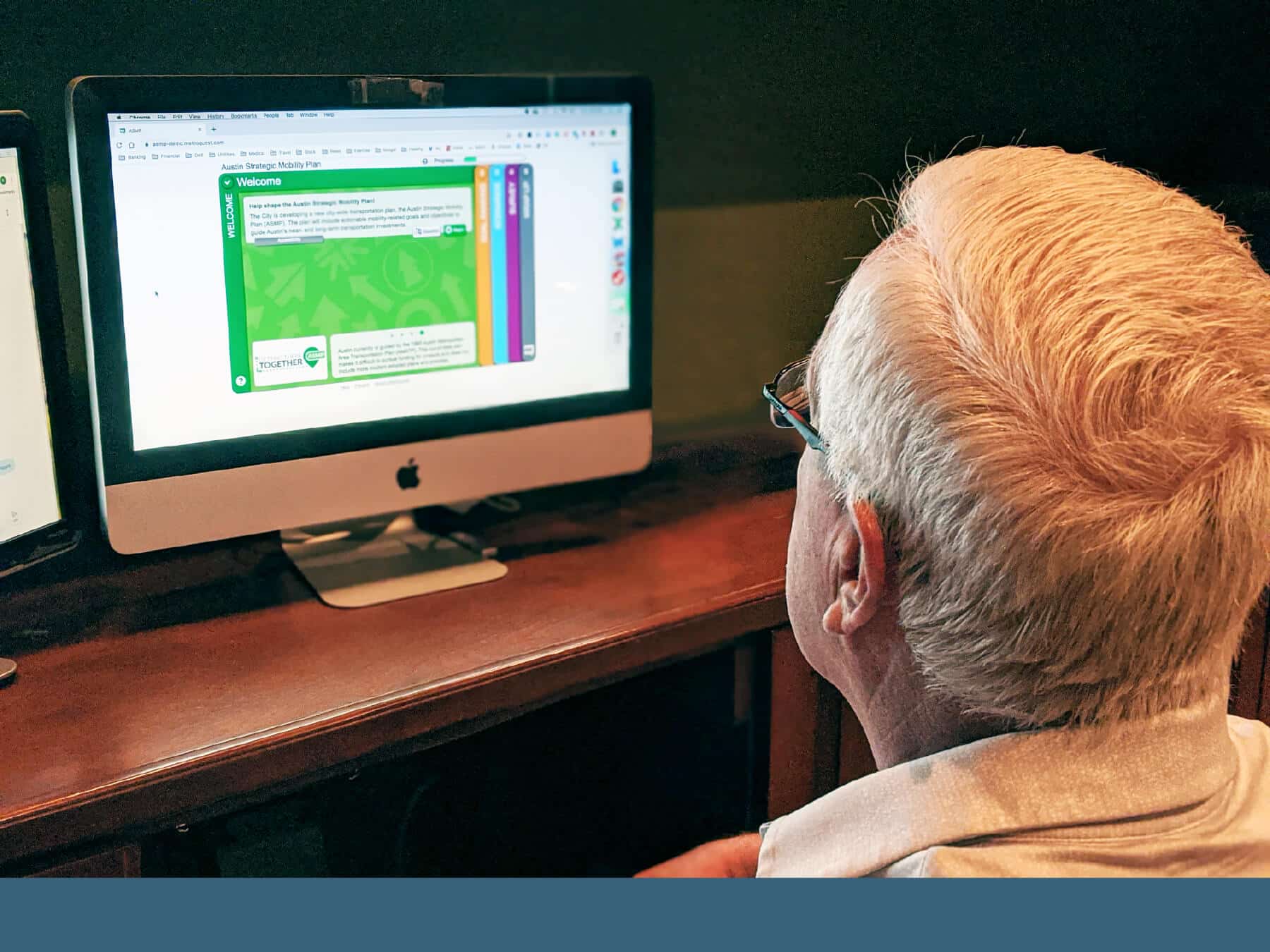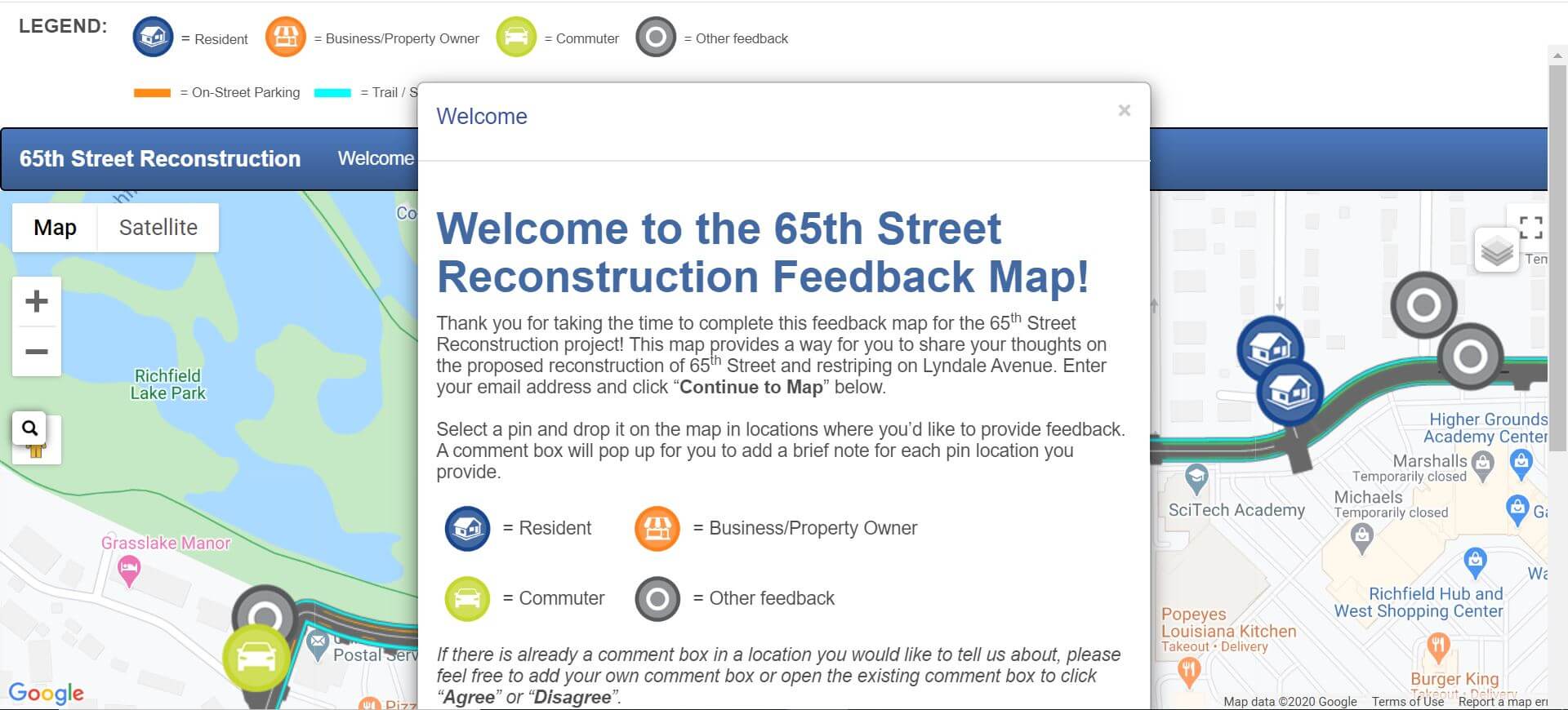- May 18, 2020
- COVID-19, Perspectives
Digital Public Engagement During COVID-19: Promoting Access in a Virtual World


Leila Bunge, AICP
Planner and Public Engagement Specialist

Jessica Laabs, AICP
Planner and Public Engagement Specialist

Leila Bunge,
AICP
Planner and Public Engagement Specialist

Jessica Laabs, AICP
Planner and Public Engagement Specialist
Prior to the COVID-19 pandemic, much of the public involvement process relied on in-person methods. Now, in a time of shelter-in-place orders and social distancing, community engagement professionals are turning to digital tools and techniques to connect with the public about their projects. Yet, many Americans, especially marginalized communities, lack digital literacy, reliable internet access, and/or infrastructure. How can we ensure that the public engagement process is accessible, inclusive, and meaningful when occurring online?
Before beginning digital public involvement, determine whether it is appropriate and/or necessary to carry out at this time. It’s important to acknowledge that we are in the midst of a global pandemic that is having significant impacts on people’s lives. There are many strategies to engage the public digitally that can foster inclusivity, and all tools and techniques need to be applied in a context-specific manner that is sensitive to your community.
Advantages and Constraints of Digital Public Involvement
Whether occurring in-person or online, thoughtful and equitable public involvement should adhere to the same principles. Inequity and exclusivity existed long before the COVID-19 outbreak and at Kimley-Horn, we are continuously working with our clients to improve accessibility standards in all aspects of community engagement, whether it’s happening online or in-person.
While not an exhaustive list, below are a few advantages and constraints of digital public involvement to consider when planning your approach.
Advantages
Broaden Your Audience
Digital approaches have the potential to help you reach a diverse and geographically-spread audience. Unlike traditional open houses or town hall meetings that occur exclusively in-person, digital tools offer convenience, allowing participants to access project information at a time and place that suits them. Attending a traditional open house can be challenging due to time constraints, limited mobility, childcare coordination, or a host of other reasons. In fact, one in seven American adults has a mobility disability, the most common disability type. Digital engagement may provide those with mobility disabilities increased access to participation in public matters.
Make Information Easier to Access
Publishing project materials and seeking input via online platforms has the potential to make the planning process and data more visible. Some online tools allow for very transparent discourse, during which users can comment and communicate with one another.

Encourage Input
Online platforms allow participants to submit responses, questions, and comments anonymously. This may give some users more confidence and motivation to share their feedback. For others, even with anonymity, utilizing and speaking up in online platforms can be intimidating. Be mindful that online communication eliminates non-verbal cues and can amplify existing inequities and gender differences in communication styles. For these reasons, it is incredibly important to provide multiple ways for the public to engage and submit feedback about your project.
Constraints
The Digital Divide
As mentioned earlier, many Americans lack digital literacy, reliable internet access, and/or infrastructure. Even if these aspects don’t present a challenge to them, online civic discourse may be difficult. Digital public engagement has the potential to favor certain voices over others, skewing perceptions of impacted communities’ priorities. Below are some suggestions to help encourage inclusive and fair representation:
- As with non-digital approaches to engagement, identify specific audiences you would like to reach and actively seek out underrepresented voices.
- Choose online platforms that prioritize user-friendliness.
- Tailor your approach to best suit your audience. For example, if you have participants that are hearing impaired, add closed captioning to your presentation.
- If participants are color-blind, ensure all graphics are color-blind safe. If your participants are predominantly non-English speaking, speak or provide materials in the language they are most comfortable using.
- Consider the types of input you would like to receive. If you are looking for location-based feedback, interactive mapping tools that allow users to drop pins and comment on specific locations may be useful.
- Acknowledge and address that learning curves may exist with online platforms, especially if your participants are using them for the first time. When possible, leverage existing platforms that participants are familiar with and comfortable using.
Diversified Participation Options
Digital platforms can lack face-to-face interaction and the ability to connect with another human in-person. While you can (and should) provide digital engagement materials in multiple formats or platforms to offer more opportunities for participation, recognize that digital public engagement is not always an appropriate replacement for non-digital approaches. If possible, diversify your engagement tools and ways you connect with people by incorporating non-digital approaches, too. Reach out to local organizations and liaisons embedded in impacted communities to share insights and amplify your project amongst their networks. Advertise via radio, newspaper, or postcard mailers. If you know that participants have limited digital skills, call them over the phone and offer to provide project materials in another format.
Without the ability to get in front of stakeholders at community gathering spots, pop-up events, and other in-person opportunities, it may be more challenging to engage with folks who would not typically participate in the public planning process and persuade them to do so. Without a consistent presence, it can be difficult to build trust with community members, especially with those whose voices have been ignored or left out previously.
Some online platforms lack a sense of reciprocity or conveyance indicating that a participant’s feedback was received and heard. Without an in-person, verbal response as confirmation, participants may wonder whether their feedback is being incorporated into project decision-making. To address this, respond and answer participants’ questions whenever possible. One potential tool is to hold “office hours” or Q&A sessions, where the public can tune in and ask questions of a project team member.
Get Started
Public involvement does not necessarily need to stop now that shelter-in-place orders and social distancing are being observed. Our community engagement experts can help develop a public engagement process that is accessible, inclusive, and meaningful now and as communities begin to reopen.
About the Authors

Leila Bunge, AICP
Leila is a planner and engagement specialist for city-, county-, and state-led projects. She has led a variety of inclusive public engagement efforts for diverse stakeholder groups through social media, community events, open houses, stakeholder meetings, and workshops. In addition to facilitating in-person meetings, Leila has created various forms of communication materials such as videos, interactive maps, websites, and presentations and ensured they met state web accessibility guidelines for online use. On several projects, Leila has helped form strategic partnerships with other agencies and interest groups to increase the client’s outreach capacity and overall awareness of the project.

Jessica Laabs, AICP
Jessica has 20 years of experience as a planner and public engagement specialist. Throughout the course of her career, Jessica has gained extensive experience working with agencies and the public, preparing and executing comprehensive engagement plans, and using stakeholder input to inform critical project decisions. She is skilled in strategizing and facilitating techniques that most effectively reach key stakeholders, including online, print, and in-person engagement. Jessica’s passion is facilitating a transparent outreach process that’s inclusive, builds understanding, and results in a positive experience for the community and the client.
